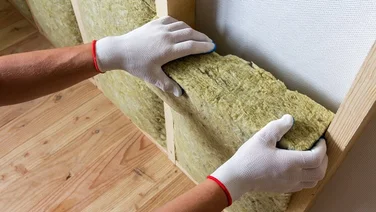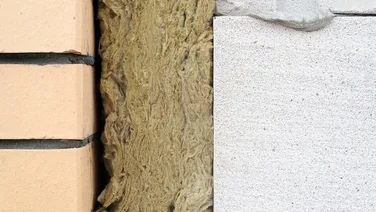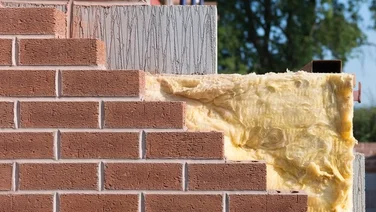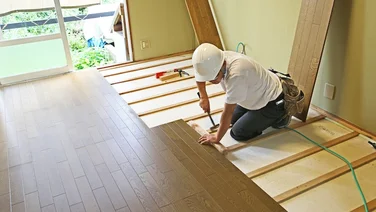- What are the best types of cavity wall insulation?
- What is the most sustainable cavity wall insulation?
- How to choose cavity wall insulation?
- Spray foam insulation
- Mineral wool
- Beads and granules
- Rigid insulation boards
- Cavity batts
- Is cavity wall insulation right for my home?
- What’s the best cavity wall insulation for older properties?
- What’s the best cavity wall insulation for newer properties?
- How do I get started?
- Summary
- Cavity wall insulation materials range in price from £5-£75 per square metre
- Mineral wool is the best option for older properties
- Rigid insulation boards or cavity batts are the best option for newer properties
- Cavity wall insulation will improve your home’s energy efficiency
There are many ways to insulate your property’s cavity walls, but some ways are better than others.
The right way for you will depend on the size of your property, how much heat you’re currently losing and what you can afford.
Whatever you choose, cavity wall insulation will help you save money and energy.
After all, about a third of all the heat lost in a home escapes through the walls (Energy Saving Trust, 2023).
In this article, we share the best cavity wall insulation options to consider for your home.
If you’re considering cavity wall insulation, you can find the best deals by simply popping a few details in this quick form.
Once we have these, we’ll put you in touch with our trusted insulation installers, who will provide you with their top deals.

What are the best types of cavity wall insulation?
The suitability of each cavity wall insulation type depends on various factors, such as the construction of your home, the climate in your area, and your budget.
Here are some of the most commonly used types of cavity wall insulation:
- Mineral wool – made from natural or synthetic fibres derived from minerals such as rock or glass
- Beads and granules – small foam particles typically made of expanded polystyrene (EPS)
- Rigid insulation boards – panels typically made from expanded polystyrene (EPS), extruded polystyrene (XPS), or polyisocyanurate (PIR)
- Cavity batts – mineral wool that has been compressed to form slabs, covered with a water-resistant film
- Spray foam insulation – a mixture of polyol resin and isocyanate that create a foam, which is sprayed into cavity walls and expands to fit the space and form a seal. Spray foam insulation has a lot of problems and we do not recommend installing it.
What is the most sustainable cavity wall insulation?
The most sustainable material you can use for cavity wall insulation is mineral fibre (according to multiple sources), which is made almost completely from recycled materials. It can be recycled itself too, so if or when you’re replacing your cavity wall insulation, your impact on the environment will be less.
Mineral fibre is often made from recycled glass, sand, and other materials. This means giving things like double glazing a new lease of life when it’s ready to be replaced, reducing waste in landfill.
Mineral fibre is also made from igneous rocks, which are heated up and spun into a fine fibre mesh. So really, mineral fibre insulation is about as natural a form of insulation as you can get.
How to choose cavity wall insulation?
The type of cavity wall insulation you should choose depends on various factors. These include the specific characteristics of your property, your insulation goals, budget, and any other considerations you believe important such as soundproofing or fire resistance.
Spray foam insulation
Spray foam insulation is applied using a spray application method. It consists of a mixture of two components, polyol resin and isocyanate, which react and expand upon contact to form a foam.
However, as noted above, spray foam insulation has a lot of potential problems, including making it harder to remortgage or sell your home, so we do not recommend it.
It’s available in two types: open-cell foam and closed-cell foam. Open-cell foam is softer and less dense, while closed-cell foam is denser and provides a higher level of insulation. The foam is sprayed onto the designated areas, conforming to the shape of the space being insulated.
The foam adheres to the surface, creating a continuous layer of insulation that effectively reduces heat loss or gain and helps to prevent moisture-related issues such as condensation.
The average price of spray foam insulation is £20-£50 per square metre.
- Provides a high level of thermal resistance with a long lifespan
- Expands upon application, creating an airtight seal, minimising air leakage and preventing drafts
- Closed-cell spray foam insulation is impermeable to moisture
- Conforms to the shape of the area being insulated, ideal for irregular or hard-to-reach spaces
- Generally the most expensive of insulation materials
- Not typically a DIY project – should be installed by trained professionals
- Spray foam can release chemicals into the air which could cause respiratory irritation and allergic reactions
- Challenging to remove or modify if required
Mineral wool
Mineral wool is an insulation material made from natural or synthetic fibres derived from minerals such as rock or glass. It works by trapping air within its fibres, which helps to reduce heat transfer.
Mineral wool insulation is installed by blowing the material into the cavity using specialist equipment. The material fills the voids, providing an effective thermal barrier. It can significantly reduce heat loss through the walls, improving the energy efficiency of a building. It also offers soundproofing benefits by absorbing sound waves.
The average price of mineral wool is £13-£17.50 per square metre.
- Excellent thermal insulation
- Good sound-absorbing properties
- Moisture resistant
- One of the cheaper insulation materials
- May settle or sag overtime, reducing its effectiveness
- Relatively dense and heavy, making it harder to install
- Can release airborne fibres during installation which can cause skin irritation or respiratory discomfort
Beads and granules
Beads and granules insulation utilises small foam particles to fill the gaps and voids in the wall cavity. These particles are typically made of expanded polystyrene (EPS). The installation process involves drilling small holes into the external walls of the property at regular intervals.
Through these holes, the foam particles are blown into the cavity using an injection system. As the particles are injected, they disperse and interlock, forming a continuous layer of insulation that fills the available space and reduces heat transfer. The drilled holes are then filled to restore the appearance of the walls.
The average price of beads and granules for cavity wall insulation is £18-£22 per square metre.
- Reduces heat transfer and improves energy efficiency
- Typically quick and non-disruptive installation
- Good flow characteristics, which helps fill cavities evenly for more consistent insulation coverage
- Good sound-absorbing properties
- May settle or compact within the cavity, reducing insulation effectiveness
- May have limited resistance to moisture
- May allow some air movement that can reduce the overall performance
- May be more expensive compared to other cavity insulation options
Rigid insulation boards
Rigid insulation boards are typically made of materials such as expanded polystyrene (EPS), extruded polystyrene (XPS), or polyisocyanurate (PIR). The boards are fixed to the surface of the wall or other areas using adhesive, mechanical fixings, or a combination of both.
The boards are cut to fit the required dimensions and then secured in place. Joints between the boards are sealed to ensure a continuous insulation layer. They work by reducing heat transfer through conduction. The closed-cell structure of the boards traps air, preventing the movement of heat.
The cost of rigid insulation boards vary slightly depending on the material used. Typically per square metre EPS boards are around £10, PIR boards cost about £5-£15 and XPS boards are £10-£15.
- Excellent thermal resistance properties
- Rigid and sturdy, providing structural support
- Moisture-resistant, preventing the growth of mould and mildew
- Usually the cheapest insulation option
- Not as flexible as other insulation materials, challenging to install in irregularly shaped or curved spaces
- Can allow heat to bypass the insulation with air gaps if not properly installed
- Improper installation can lead to moisture-related issues leading to rot or corrosion
- XPS and EPS are derived from petroleum-based products so not environmentally friendly
Cavity batts
Cavity batts are typically used in new builds or extensions where the cavity width allows for full-fill insulation. The batts are slabs of mineral wool that have been compressed together and covered with a water-resistant film. The slabs are fitted tightly together to fill the entire void, reducing heat transfer through the walls.
The typical cost for cavity batts ranges anywhere from £12 to £75 per square metre depending on the thickness of the batts.
- The most fire resistant of insulation materials
- Lightweight and easy to install
- Have a water-resistant coating
- Made from eco-friendly materials, such as recycled or sustainable fibres
- Can only be installed in the process of building a home, can’t be retrofitted
- Not as efficient at insulating compared to foam that expands or beads that fill gaps
- Can retain moisture, leading to dampness or condensation issues, if improperly installed
- Costly to install when thicker batts are required
Is cavity wall insulation right for my home?
There are lots of advantages to getting cavity wall insulation. Before you do, consider the following:
- Check to see if your home has a cavity that is suitable for insulation
- Suitable walls must have a cavity that is at least 50mm wide
- Your property must meet the necessary building regulations and requirements for cavity wall insulation
- Factors such as exposure to wind-driven rain, brickwork in bad condition, and the presence of damp or structural issues should be considered too

What’s the best cavity wall insulation for older properties?
The best type of cavity wall insulation for older properties is mineral wool. This is because older properties are often more prone to issues such as moisture and condensation, which mineral wool is designed to prevent. It’s also more fireproof too, increasing safety.
You’ll get better sound isolation with mineral wool as well, something that’s often lacking in some older properties with thinner walls.
Lastly, mineral wool is breathable, which can be an essential quality for older buildings. You don’t want condensation building up in older buildings, as they could have timber structures and excess moisture can damage these.
What’s the best cavity wall insulation for newer properties?
The best type of cavity wall insulation for newer propers is rigid insulation boards. They have excellent thermal insulation properties and can help increase the structural integrity of walls.
Additionally, they’re typically moisture resistant, which helps maintain a dry and moisture-free cavity, reducing the risk of damp or mould appearing.
How do I get started?
There are various options when it comes to cavity wall insulation – and the first step to take is to understand exactly what you need.
Consulting with insulation professionals or surveyors should be the first step you take as they can help evaluate the suitability of different insulation types and recommend the most appropriate solution for your home.
To find the best deals for insulation, we can put you in touch with our trusted insulation installers. Simply add a few details into this quick form and they’ll get in touch directly with their best deals.
Summary
- Cavity wall insulation will save you money and energy, but it’s important to understand what you can afford before you get started.
- Spray foam insulation is not eco-friendly and can potentially make it difficult to sell your home or get a mortgage.
- If you have an older property, mineral wool will probably work best.
- Houses that are timber-framed, steel-framed or experiencing penetrative damp shouldn’t have cavity wall insulation. Nor should those with a cavity wall under 50mm or over 150mm.
- If you’re considering cavity wall insulation, you can find the best deals by simply popping a few details in this quick form.







